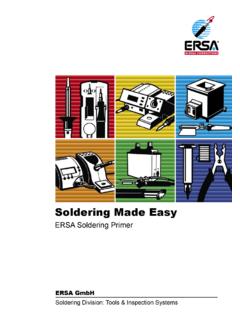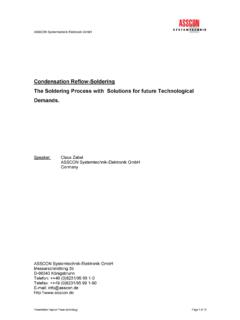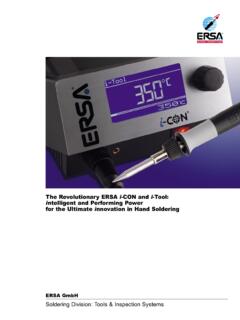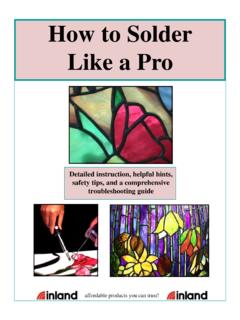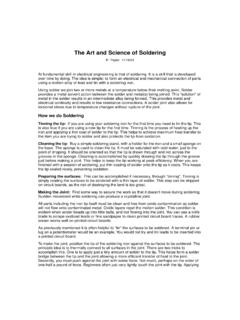Transcription of HI-FORCE SOLDER - Brownells
1 076-200-345 March 06r 2006 Brownells , INC. MADE IN Brownells Hi force 44 SOLDER is without a doubt, the most useful and versatile SOLDER available to the gunsmith. This SOLDER is a composition of 4% silver and 96% tin with a tensile strength of up to 25,000 psi, yet it flows at the relatively low temperature of only 475 F. It does not require the tremendous heat of hard or sil-ver solders, often 1000 F. or more, that can ruin blu-ing and destroy heat-treating. Yet, like most high temperature solders, it is impervious to normal caustic bluing salts. In short, HI-FORCE 44 provides the gunsmith with the best of both worlds!
2 In soldering , the metal surface of the workpiece actually fuses or alloys with the SOLDER . This intermetallic mixture is physically different than either the SOLDER or the metal of the workpieces and normally has a much greater strength than the SOLDER alone. HI-FORCE 44 is suitable for use with carbon steel, most stainless steel alloys, brass and TO USE When soldering , cleanliness is of the greatest importance. All grease, oil and dirt must be cleaned from the surface of the workpiece where SOLDER -ing is to be done. Make certain the fumes from any solvents used to clean the parts have dispersed BEFORE lighting your torch! ANY material or substance that inhibits the contact and fusing of the SOLDER with the metal of the workpiece MUST be removed.
3 This includes rust, scale, bluing, paint, etc. The surface of the workpiece must be cleaned down to the bare metal. When the metal of the workpiece is exposed to the atmosphere, the process of oxidation begins IMMEDIATELY! Even if you cannot see the oxidation, it is there. One of the major functions of a flux is to remove this layer of oxidized metal so the SOLDER can bond with the surface of the workpiece. When applying heat, either from a propane or oxyacetylene torch, direct the heat ONTO THE WORKPIECE. DO NOT HEAT THE SOLDER ! If heat is applied to the SOLDER , the SOLDER will melt, but it will not adhere to the workpiece. The SOLDER should be melted by the transference of heat from the work-piece.
4 Heat the workpieces and let them melt the SOLDER . If the workpieces are overheated the SOLDER will melt, but it will bead and will not adhere. You must control the temperature of the workpieces to within a few degrees of the melting point of the SOLDER , 475 F. If it is too high, the SOLDER will bead up and run off the workpiece; if too low, the SOLDER will not melt. There is no substitute for practice soldering to develop a feel for proper heat applica-tion. With experience, it becomes easier to judge how much heat should be applied for the best result. Mass also complicates the heating process. Larger workpieces require more heat or a longer time to come up to the proper temperature than do smaller pieces.
5 If two workpieces of different sizes are to be soldered to-gether, the smaller piece will normally require less heating than the larger piece in order to have them achieve the same temperature level simultane-ously. Again, practice and experience are required to master the art of ORIGINAL,NON-FLUXED HI-FORCE 44 SOLDER After cleaning the area of the workpiece to be soldered, heat it to the ap-propriate temperature and apply the flux to the workpiece. For HI-FORCE 44 SOLDER , we strongly recommend our No. 4 Comet Flux for optimum results. IMPORTANT SAFETY NOTE Because of the high temperature involved in soldering , it is manda-tory that you ALWAYS wear protective gloves, safety glasses or full face shield, a heavy duty shop apron, and a long-sleeved shirt.
6 All soldering must be done in a well ventilated area where fumes from any fluxes, solders or combustible material can be dispersed. Always make sure that your workpieces are properly secured in an appropriate vise or holding fixture. When working with soldering or welding equipment, ensure that your work area is free from all combustible material and that you have an appropriately rated fire extinguisher readily accessible. Be very care-ful and exercise extreme caution to avoid personal injury or property SAVE THESE INSTRUCTIONS IN YOUR Brownells GUNSMITHS DATA RING BINDERHI-FORCE44 SOLDERREAD & FOLLOW THESEINSTRUCTIONSBe very careful with the flux and use sparingly; it will remove bluing!
7 A cot-ton tipped swab is excellent for applying small, controlled amounts of flux. When two pieces are to be joined, it is often best to tin each of the pieces. Tinning is a procedure where a thin coat of SOLDER is applied to the work-pieces where they will join. The procedure is simple; first clean, heat and flux the bottom surface of the first part and apply a very thin coat of SOLDER to the joining surface. Remove any excess SOLDER while it is still molten with a clean, cotton patch or felt cloth. Follow the same procedure on the joining surface of the second part. After both have cooled to where they can be handled, position them as needed for final assembly and clamp together.
8 Apply heat carefully to BOTH parts so both come up to the desired soldering temperature, 475 F., simultaneously. At this point the SOLDER will flow and cool; the two parts will be firmly joined. It is often helpful to use a small amount of flux between the two tinned parts when bringing them up to temperature. To help pull SOLDER to the edge of the seam and give the joint a more fin-ished appearance, apply just a drop of so of flux with a small, pointed, me-tal rod to the seam, or joint, between the two parts just after the SOLDER melts. HI-FORCE 44 Ribbon is extremely useful in joining sight ramps to barrels; it eliminates the need to tin the parts.
9 Cut a length of Ribbon about 1 8" to 3 8" shorter than the length of ramp to the soldered, taking into account any screw holes in the ramp or barrel. Remove all bluing, Parkerizing or oxida-tion from both parts as you would if you were using HI-FORCE 55 wire. Apply No. 4 Comet Flux to both parts with a cotton tipped swab. Be careful be-tween the ramp and barrel, and clamp them together using a spring-loaded, Brownells Ramp soldering Jig. Apply heat carefully to BOTH the ramp and barrel with most of the heat going onto the barrel (the most massive part).200 S. Front St. Montezuma, IA 50171800-741-0015 or 641-623-4000 s Largest Supplier of Firearms Accessories and Gunsmithing Tools.
10 USING FLUXED HI-FORCE 44 SOLDER Tin the individual parts by heating them to the melting point of HI-FORCE 44 and holding the end of the wire against the part. Move the SOLDER around to help the flux flow out of the wire as the wire is melting. When you have a blob about the size of a wooden match head on the part, quickly use a cotton tipped swab to move it and its flux around to cover the area being tinned. Leave a uniform, thin layer of SOLDER on the surface. Allow the parts to cool and clamp together into their assembled relationship. Re-heat both parts to the melting point of the SOLDER (about 475 F.) and touch the end of the SOLDER wire to the joint, allowing a little extra SOLDER and flux to flow into the joint.





